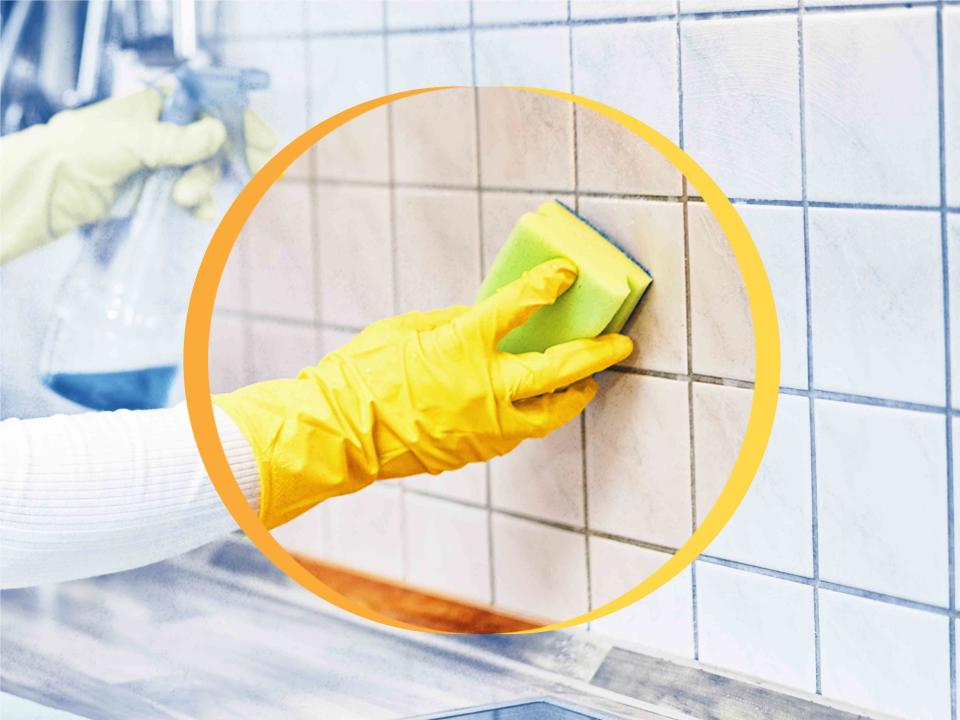How to Remove Grease From Your Kitchen Backsplash, According to a Professional Cleaner
Get rid of those pesky grease stains once and for all.

Dotdash Meredith / Janet Maples
Many people clean their cooktops and countertops after each round of cooking, but tend to forget the backsplash. Since the backsplash is one of the most overlooked kitchen areas, grease splatters can build up over time and become difficult to get rid of.
What Causes Grease Stains on Your Kitchen Backsplash?
A food scientist, Bryan Quoc Le, Ph.D., explains how the pesky grease builds up over time:
As cooking oil from animal fats and vegetable oil heats up, it is more prone to oxidation. The grease that lands on the kitchen backsplash undergoes chemical reactions that cause the oil to polymerize as it reacts with the surrounding air, solidifying it into place. He adds, “This creates very large molecules that are difficult to dissolve, even with soap and water.”
If you don’t degrease the kitchen backsplash after each round of cooking, the grease and oil remnants build up as a solid over time. The backsplash eventually becomes greasy to the touch—and if the greasy deposits aren’t removed, the oil will continue to build up, making the grease more difficult to get rid of.
How to Remove Grease Stains on Backsplash
Removing the pesky grease splatters on the backsplash can’t be any easier. Our experts share how store-bought and home hacks can remove greasy stains.
1. Store-bought Degreaser
Delah Gomasi, founder, owner, and managing director of MaidForYou, recommends using a degreaser of your choice to clean your kitchen backsplash. He suggests spraying the degreaser on a microfiber cloth to clean the affected area, then wiping until the oil has been removed.
Gomasi also recommends using a combination of dish soap and water to remove the leftover degreaser. Rinse and repeat this until the microfiber cloth comes away clean.
2. Baking Soda
Baking soda dissolved in water can be applied to grease stains, Quoc Le says. He adds, “Grease is made up of fatty acids. When baking soda comes in contact with grease deposits, a chemical reaction called saponification occurs.”
This chemical reaction makes the grease soapy, enabling the grease’s removal from the backsplash tiles.
To make this baking soda solution, use one part of baking soda for every two parts of water, which becomes a paste. Then, follow these steps to remove the grease:
Place the paste over the affected area for 5 minutes.
Wipe down the backsplash with a clean rag.
Put additional paste-like baking soda solution over the tiles and wipe it down until the grease is completely removed.
3. Cornstarch
Cornstarch is a natural degreaser that absorbs grease.
When a splatter happens, act right away by sprinkling a liberal amount of cornstarch over the affected areas and letting it sit for 15 minutes. Then, use a soap-and-water mixture and a soft cloth or rag to wipe off the powder. This method may seem like you have more cleaning, but it is an effective home hack to remove new grease stains.
For the tougher stains that won’t budge, here is what you can do:
Make a mixture with one part water to two parts cornstarch that becomes a thick consistency.
Use a knife or spoon and spread a thick layer over the affected area.
Allow the paste to sit for 24 hours before wiping it off with a clean towel.
Cleaning Backsplash Tile vs. Grout
Grout is the hardened material that fills the gaps between tiles, including the tiles on the kitchen backsplash.
Since the backsplash has a smooth surface, Gomasi and Quoc Le indicate using soft materials (like a cloth towel) to wipe down the surface.
But grout is a porous material that is much more difficult to clean without an abrasive tool. Gomasi suggests the following method:
Use a toothbrush or a hard-bristled brush dipped in a degreaser to wipe away leftover oil.
Use the same brush with a mixture of dish soap and water to wipe away the rest of the degreaser.
Rinse and repeat until the water from the brush runs clean.
How Often Should You Clean Your Backsplash?
As mentioned earlier, maintaining a clean kitchen also involves cleaning the backsplash after food prep and cooking. Wipe down the backsplash with soap and water mixture after each round of cooking to remove the bulk of the oils, preventing them from oxidizing and building up.
Gomasi recommends cleaning the backsplash at least once daily with mild dish soap and water as part of your nightly kitchen routine. Additionally, using a degreaser, baking soda, or cornstarch every week can also help maintain a clean and sparkly kitchen backsplash.
Read the original article on All Recipes.

 Yahoo Lifestyle
Yahoo Lifestyle 
